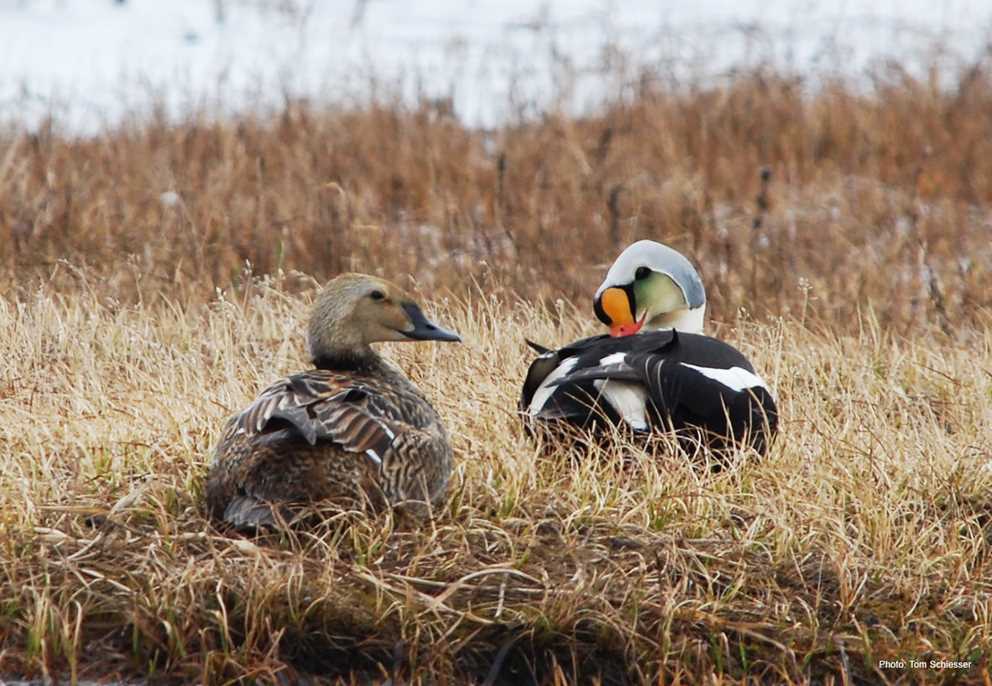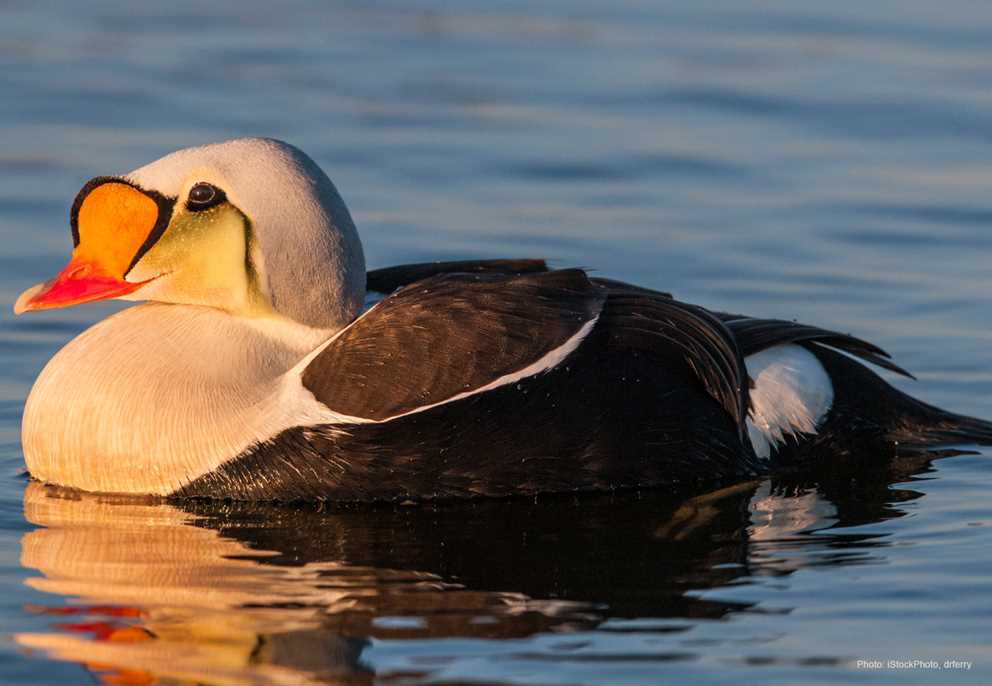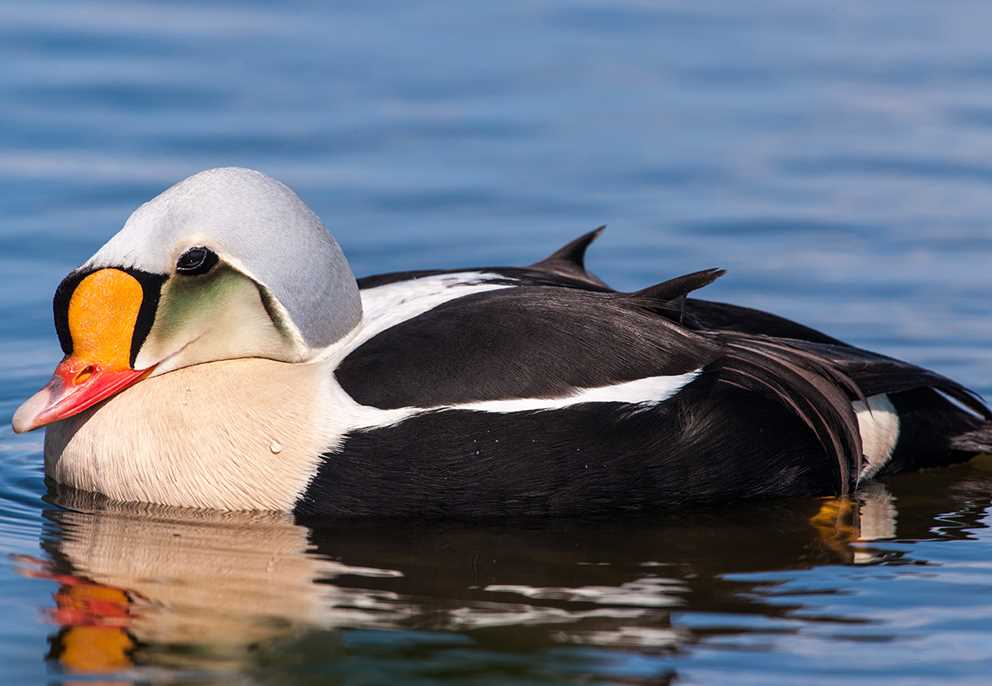Overview
The King Eider is a medium to large sea duck with a circumpolar distribution. In North America, they are separated into Pacific and Atlantic populations based in part on separate wintering areas. The Pacific population breeds in the Arctic from Alaska to the Queen Maud Gulf, while the Atlantic population breeds from Victoria Island east to Greenland. The Pacific population winters in marine waters of southwestern Alaska and the Alaska Peninsula, while the Atlantic population winters in marine habitats from Newfoundland south to New Jersey.
Adult males are among the most striking ducks in North America, with a light blue forehead, crown and nape, iridescent pale green cheeks separated from the nape by thin black and white lines. The bill is orange with a frontal lobe outlined in black. The lower head, neck and breast and upper back are white, main body is black with a large white patch on the side of the rump. Females are reddish brown and show substantial black barring on the back and sides. The head has a buff eye ring and eye stripe on head.
Nests in coastal and inland tundra wetlands, and winters in coastal and offshore marine waters as far north as sea ice will permit.
Description
Key Identification Features
- In flight, male King Eiders show a conspicuous white patch associated with upper wing and middle coverts, while female wings are mottled brown with lighter brown or buff on the upper and middle coverts.
- The male has a light blue head with iridescent green cheeks and a large orange-yellow bill with a frontal lobe outlined in black.
- Females are mottled reddish-brown, with black barring and a buffy eye ring and line through the eye.
Male/Female Average Length and Weight
- Mass: Males 3.1–3.6 lbs.; Females 1.8–4.7 lbs. Females lose substantial mass during nesting and incubation, resulting in a wide range.
- Wing Length: Males 11 in.; Females 10.8 in.
Male Identification
- Alternate (Breeding) Plumage: Adult males are among the most striking ducks in North America, with a light blue forehead, crown and nape. Iridescent pale green cheeks are separated from the nape by thin black and white lines. The bill is orange with a frontal lobe outlined in black. The lower head, neck, breast and upper back are white, while the main body is black with a large white patch on the side of the rump. The back and sides are separated by a white patch on the wing coverts. The back, belly rump and vent are black, and the black scapular feathers have long curved extensions, often referred to as sails. In flight, males show a large white patch on the upper wing coverts.
- Basic Plumage: Dull gray-brown overall, with a dull yellow bill. A cryptic plumage attained in summer (typically July/August) while birds are molting flight feathers.
Female Identification
- Alternate and Basic Plumage: Females are tawny reddish brown with darker barring. Females show brown wings with a lighter brown patch on upper and middle coverts. Alternate and basic plumages are similar.
In-Flight Identification
- Male: Male King Eiders show a conspicuous white patch associated with upper wing and middle coverts.
- Female: Female wings are mottled brown with a lighter brown or buff patch on the upper and middle coverts.
Vocalizations
- Male Calls: Males give a soft, dove-like “urrr, urrr” sitting on water.
- Female Calls: Females may give a murmuring growl in migration flight with and various croaks and grunts.
Similar Species
- Common Eiders: Adult male King Eiders are distinctive in plumage, with the large orange-yellow frontal lobe on the bill and a large, square head appearance. They have less white on the back and upper wings in comparison to Common and Spectacled Eiders. Separation of females from Common Eiders is challenging, but King Eiders have rounder head and more subtle markings overall. Steller’s Eider is smaller and has blue speculum that is absent in King Eiders.
Habitat Preferences
- Breeding: King Eiders are among the northernmost breeding birds in North America, using Arctic coastal tundra and inland tundra wetlands.
- Migration and Wintering: During winter, they are found in northern coastal and offshore marine waters as far north as the edge of sea ice.
Foraging Habits and Diet
- Breeding Season: King Eiders feed extensively on invertebrates throughout the annual cycle. During spring and summer, they eat aquatic insects, seeds, and aquatic vegetation.
- Migration and Winter: Echinoderms, mollusks, and crustaceans are frequently consumed during winter.
Breeding Habits
- Monogamy: King Eiders are seasonally monogamous, with pair bonds formed in winter and lasting until incubation. Most females nest at 3 years of age, though some two-year-old females will nest.
- Nest Locations: Females create a nest bowl lined with grasses, sedges and lichens, and deposit down as laying progresses. Nests are located close to water on islands, peninsulas, or pond shorelines.
- Clutch Size: Clutch size averages 4–5 eggs. The eggs are elliptical ovate to elongated ovate, pale olive or olive buff, and 2.6–3 by 1.6–1.9 in. The incubation period averages 22–24 days. Given their Arctic breeding range, King Eider nest initiation is typically from late June to early July, and they are not known to renest.
Migration & Distribution
- Fall Migration: King Eiders depart breeding wetlands in July or August prior to freeze-up. Initial movements are to molting areas and subsequently to migration and winter areas. Arrival on migration and winter areas is variable, beginning as early as August and continuing through October.
- Spring Migration: Spring migration is later given the need to arrive on Arctic nesting areas after ice out, usually in late May to mid-June. Often migrates in impressive flocks numbering in the thousands.

Conservation Status
- IUCN Status: Least Concern
- Population Status: There is an estimated global population of 1.5 to 3 million birds, with the North American population being 1–2 million. Studies suggest both the Pacific and Atlantic populations of North America are declining, though estimates are variable.
- Conservation Concerns: Primary threats include habitat loss, oil spills, and adverse effects of climate change on habitat quality and food resources.
- Conservation Focus: Conservation efforts focus on public education, improvements in population estimation, protection of important habitats, and ensuring sustainable harvest regulations.
Harvest Information
- Harvest estimates are not readily available for Common and King Eiders separately. The following statistics are based on data from 1999 to 2008.
- From 1999 to 2008 the average annual US harvest of King Eiders was about 500, while an estimated 20,000 King Eiders were subsistence harvested in Alaska and Canada.




